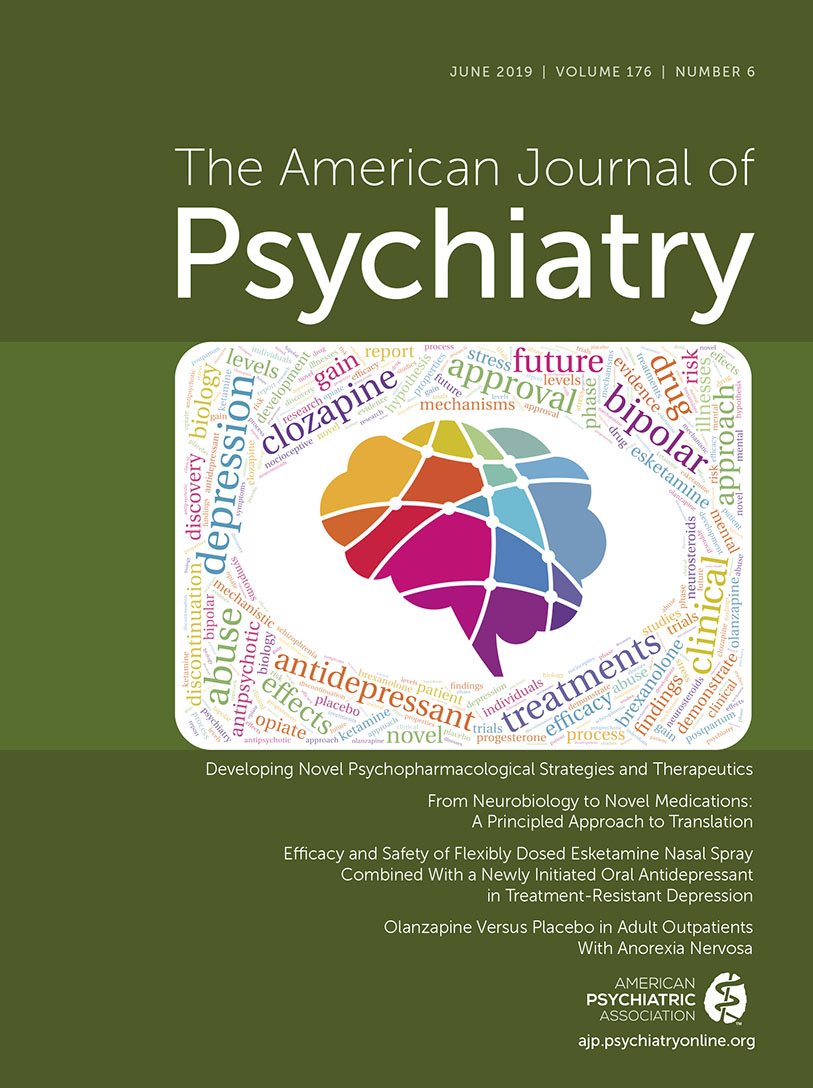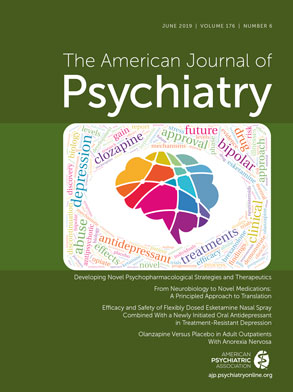This issue of the Journal is organized around articles that present findings relevant to the development of new pharmacological strategies for the treatment of our patients. As we know, there is a great need for us to discover new treatments as well as to develop novel treatment strategies with compounds that are already available. Unfortunately, our current treatments are limited in scope and efficacy and are targeted toward only a handful of neurotransmitter systems. That said, it is important to emphasize that we have had some recent successes, which include the approval of esketamine for treatment-resistant depression and brexanolone for postpartum depression. In this issue, we are fortunate to have Dr. Joshua Gordon, director of the National Institute of Mental Health (NIMH), contribute an overview that presents his perspective and the NIMH vision regarding the development of new therapeutic strategies for psychiatric patients.
The earlier large clinical trials for major depression (Sequenced Treatment Alternatives to Relieve Depression [STAR*D]) and schizophrenia (Clinical Antipsychotic Trials of Intervention Effectiveness [CATIE]) provided useful, clinically relevant information but illustrated the need for new and improved treatments. In STAR*D, recall that with one adequate trial of citalopram, approximately one-third of patients reached remission (
1), and with four different sequential treatment strategies, 67% of patients became fully well (
2). It is noteworthy that these statistics do not take into account the many patients who dropped out of the study prior to completion. Phase 1 of CATIE, the large-scale schizophrenia treatment study, compared “atypical” antipsychotics to the older antipsychotic perphenazine (
3). The results underscored the intolerability and high rates of discontinuation of these treatments, with 74% discontinuing treatment because of side effects or lack of efficacy during the 18-month trial. And in general, with the exception of olanzapine, which had a significantly longer time to discontinuation, the rates of and time to discontinuation of medication treatments did not differ when three of the newer antipsychotics—quetiapine, risperidone, and ziprasidone—were compared with perphenazine. The medications also did not differ in relation to their neurocognitive effects or psychosocial outcomes. Significant side effects were apparent for all of the medications, with weight gain and metabolic alterations being the most prominent with olanzapine use. From various studies, we also know that clozapine is the most effective antipsychotic treatment for patients who do not respond well to other antipsychotics (
4,
5); however, clozapine has its own issues with the requirement to regularly monitor absolute neutrophil counts.
In this issue of the
Journal, we present six original research articles that have implications for the clinical care of our patients. The issue leads off with results from a clinical trial by Popova et al. (
6) assessing the efficacy of nasally administered esketamine for treatment-resistant depression. The data from this trial, as well as from others, build on studies using intravenous ketamine and formed the foundation of the information presented to the Food and Drug Administration (FDA) for the recent approval of the esketamine nasal spray for treatment-resistant depression. In addition to its rapid action, esketamine represents an opportunity for using a treatment with a new mode of delivery and new mechanism of action involving
N-methyl-
d-aspartate antagonism, and potentially neurotrophic (
7) or opiate systems (
8). Dr. Alan Schatzberg from Stanford University contributes an instructive commentary on the Popova et al. article, cautioning practitioners to be aware of nasal esketamine’s abuse potential and possible severe discontinuation effects, including a warning about suicidality (
9).
The article by Earley et al. (
10) in this issue provides evidence for the efficacy of cariprazine—the atypical D
3/D
2 and 5-HT
1A partial agonist antipsychotic—in the treatment of bipolar I depression. In this phase 3 study, over a 6-week period, patients with bipolar depression did better with cariprazine relative to placebo. Effect sizes were modest and similar to those for other atypical antipsychotics approved for bipolar I depression monotherapy, which include quetiapine and lurasidone. Bipolar depression can be particularly difficult to treat, and the use of traditional antidepressants has been of concern because of the possible induction of hypomania or mania. Cariprazine is approved by the FDA for the treatment of mania, and the present finding provides additional evidence for the utility of this agent in bipolar depression.
Two articles in this issue are focused on the weight gain–inducing properties of olanzapine. Attia et al. (
11) explore the utility of using this well-known adverse effect of olanzapine to a clinical advantage by enhancing weight gain in adults with anorexia nervosa. In their 16-week randomized clinical trial, the authors demonstrate that olanzapine, relative to placebo, results in modest weight gain but fails to improve the psychological symptoms associated with anorexia. In another study, a novel approach is used to ameliorate the weight gain associated with olanzapine use in patients with schizophrenia. Here, Martin et al. (
12) demonstrate that cotreatment with the mu opioid antagonist samidorphan mitigates, but does not prevent, olanzapine-induced weight gain. Importantly, in this phase 2 study, the addition of samidorphan to olanzapine did not reduce the antipsychotic efficacy of olanzapine. Although weight gain was reduced, the authors failed to demonstrate that samidorphan had a significant positive impact on the metabolic alterations (e.g., lipid and glucose levels) associated with the use of olanzapine and other atypical antipsychotics. This is important, as the focus of these strategies should be on ameliorating the physiological determinants of metabolic syndrome. This study, along with a previous study published in the
Journal by Williams et al. (
8) implicating opiate mechanisms in ketamine’s antidepressant efficacy, underscores the importance of opiate systems in mediating behaviors, emotions, and potential treatment effects that are significant to our patients. This highlights the value and opportunities in further investigating opiate-modulating compounds as possible therapeutic strategies.
Finally, two articles in this issue use biological measures, positron emission tomography (PET) imaging, and genomics to 1) suggest a potential drug target for treating cocaine abuse and 2) evaluate the influences of genetic variation in determining clozapine plasma levels. In a study of patients with cocaine use disorder, Narendran et al. (
13) used PET imaging to demonstrate an increase in the nociceptive opioid receptor in various brain regions after 2 weeks of abstinence. Furthermore, animal model studies demonstrate that nociceptin and its endogenous receptor, nociceptive opioid receptor, have stress-reducing effects, and the receptors have also been demonstrated to affect reward systems. In the present study, the in vivo demonstration of increases in these receptors in patients with cocaine use disorder supports the idea that the nociceptive opioid receptor could serve as a target for the identification of new drugs that could be tested in the treatment of addiction, particularly cocaine abuse.
In the article by Pardiñas et al. (
14), the authors discuss the importance of understanding clozapine plasma levels in relation to treatment outcomes and side effects. In this report, a genome-wide association study approach is used to identify genetic alterations that account for individual differences in plasma levels of clozapine and its pharmacologically active major metabolite, norclozapine. In studying 2,989 individuals who were treated for treatment-resistant schizophrenia, the authors find evidence for the involvement of genetic variation in the metabolic liver gene families cytochrome P450 (CYP) and UDP-glucuronosyltransferase (UGT) in determining clozapine plasma levels and its metabolism. Because of the potential clinical relevance of the effect sizes observed, if replicated, these findings suggest the possibility of using these genetic variants in pharmacogenetic testing to inform treatment decisions regarding clozapine use.
Despite our best efforts, many of our patients continue to suffer. We simply need new treatments. Taken together, the articles in this issue report on new findings relevant to clinical psychopharmacology, some of which are directly applicable to our patients. In addition to these findings, we anticipate and look forward to future advances. The most successful efforts will result from the combined research efforts of NIMH, industry, and academia that focus on the imperative of developing new treatments that will meet the needs of our patients with treatment-resistant conditions.

